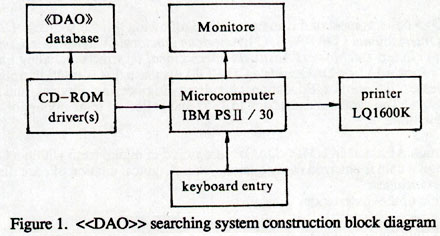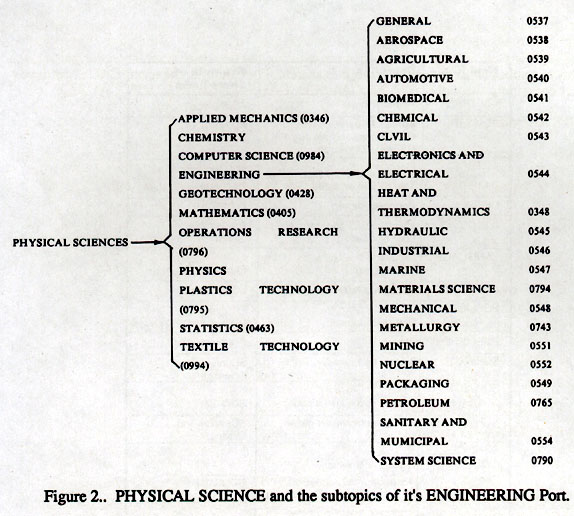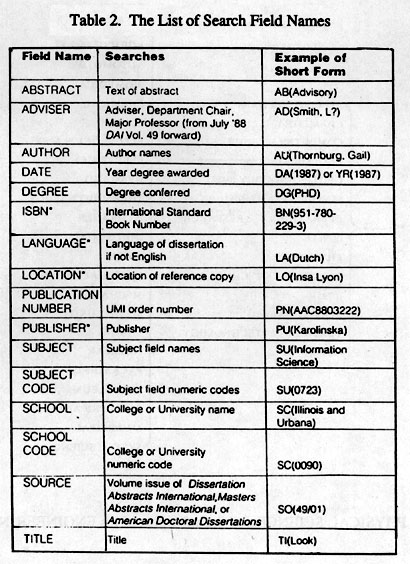
Li Mu Lan
Tianjin University Library
Tianjin, 300072 P.R. China
Abstract: This paper introduces a CD-ROM type search tool of dissertations --<<Dissertation Abstracts Ondisc>> ( DAO ). It is a new Product which has made use of optical disc technology by UMI in recent years. <<DAO>> contains bibliographic citations and abstracts for doctoral dissertations (as well as some master's theses) completed at about 1,000 accredited North American and European colleges and Universities.
<<DAO>> collects most of the contents of the following printed sources: Dissertation Abstracts International ( DAI-A, B, C ), American Doctoral Dissertations, Comprehensive Dissertation Index, and Masters Abstracts International (abstracts including master's theses from 1988 forward ). << DAO >> is a CD-ROM database that is multidisciplinary. There are Businesses, Economics, Education, chemistry Engineering, Physics, and Psychology in <<DAO>>. The database dates back to 1861 and collects a total amount of over 550,000 citations.
Dissertation Abstracts in UMI<<DAO>> are stored in digital form within a CD-ROM of 12cm. Digital data is changed every quarter year. A typical citation of each dissertation in <<DAO>> includes:
• Full title of the dissertation.
• Dissertation Abstracts International volume, isle and page number.
• UMI Publication Number.
• Author's name.
• Degree.
• College University and its four-digit code.
• Degree year.
• Number of pages.
• Subject area(s) and its four-digit code.
• Abstract of The dissertation for Degrees granted after 1980.
In order that the data information can be read on the CD-ROM and the search function can be completed,we must be provided with the appropriate hardware and software. The requirements of <<DAO>> are as follows:
The Hardware:
• An IBM ®XT, AT100 percent Compatible computer or the IBM PS/2.
• At least 450 KB of memory must be available for processing after The system is booted. A machine with 640 KB of memory should meet This requirement.
• one or more floppy disk drives.
• A hard disk drive with at least 4 MB available disk space.
• Monochrome or color monitor
• CD-ROM drive(s) with The appropriate device driver(s)
• printer(optional)
The Software:
• Microsoft's MS-DOS® CD-ROM Extensions(MSCDEX),Version 2.00r still newer.
• The UMI CD-ROM Retrieval software Installation Diskettes 1 and 2 (red)
• Appropriate Product Installation Diskettes for each of your UMI Products (blue).
Note: MSCDEX requires the DOS operating system with version 3.1 or newer.
The searching system is composed to meet the above mentioned requirements in our library. The constructional block-diagram of The searching system is shown in Figure 1:

The operation of<<DAO>> is controlled by functional Keys. The
user uses functional keys to open and close the system, display the main
menu, select words or searching strategy, display the result of searching,
print or save to a file,order dissertation copies, change discs, and browse
system, etc . The important functional keys are shown in table 1.
Table 1. Important Keys List
Key Name Function
<F1> Help.Opens and Closes Help Windows.
<F2> Display the function Key available
<F3> Search.Begins a new Search or allows Changes to a Previous search
<F4> Prints or Saves to a file
<F5> Browse.Begins a Subject browse.
<F6> Opens Word Index window.
<F7> Goes to first full record item in search result.
<F8> Order Dissertation.
<F9> Marks items for output.
<Shift>+<F4> Restarts from Menu.
<F4> Output options.
<Alt>+<F10>
Change Disc./#n#b
2. THE FEATURES OF THE SEARCHING SYSTEM
In order to help users using this system quickly, accurately and conveniently, this database has a main menu. It can introduce promptly the following contents to the users:
• Introduction to <<DAO>>
• How to Use <<DAO>>
• Search The <<DAO>> database
• Browse a Subject Area.
• Change to another UMI Disc.
• Exit from system.
The browsing function allows users to scan a list of subjects and subdivisions under subjects and ranges of years, and then open the database to that subject and year.
For example: CHEMISTRY-ORGANIC CHEMISTRY-1985.
So, "browsing" the <<DAO>> database is like browsing through a paper copy of Dissertation Abstracts International from the beginning to the end conveniently.
The database also provide"Word Index". It allows users to scan and pick a term from all of the searchable words in the database. It has two functions: One is dictionary function, the user can use The Word Index to look for variant word endings and as an aid in spelling, and the other is to look for subject word quickly and accurately, so that we can know the amount of document more exactly.
<<DAO>> database permits users to use search connectors (logical or Boolean operators, proximity operators, and segment operators) to combine search words and phrases. Using logical operators (AND, OR, AND NOT )to combine words and phrases can reduce or extend the range of Searching. But we can't limit the position of the document record between the two searching words, so it's too difficult for us to express the demand of some searching subjects. Thus, leading to reduce the searching accuracy In order to make up this kind of scanty, the user can use proximity operators to express the logical relationship between the searching words, so that the searching strategy is more strict and accurate
The <<DAO>> searching system automatically searches for both the singular and plural forms of words that form their plurals by adding "S" or by changing "y" to "ies". However, if the word ends in "ss","as","is" "os"or "us", the system does not truncate the final character.Then the user must add the truncation symbol (?) at the end of a word to search. For example, the term: CAUS? retrieves documents containing the words CAUSE,CAUSED, CAUSAL, CAUSATION,CAUSTIC, etc.
3. WAYS OF SEARCH
3.1. Subject Search
<<DAO>> database summarizes The following ten major subject areas for users to search:
(2) EDUCATION
(3) LANGUAGE, LITERATURE, AND LINGUISTICS
(4) PHILOSOPHY, RELIGION, AND THEOLOGY
(5) SOCIAL SCIENCES
(6) BIOLOGICAL STUDIES
(7) EARTH SCIENCES
(8) HEALTH AND ENVIRONMENTAL SCIENCES
(8) PHYSICAL SCIENCES
(10) PSYCHOLOGY.
After the user knows the Searching Subject, he can select relevant subject words from subject area(s).
2.2.2. Searching Fields
Other features of the <<DAO>> database include the designated title, author, Subject, publication number (UMI ordering number), date of degree awarded, school of degree awarded, etc. Altogether there are sixteen searching entrances (shown in Table 2). The subject codes and school codes of table are four-digit codes, which are replaced by subjects and schools. The numeric codes make it more accurate and faster for the user to search.
Searching Example:

• After analyzing the subject, we decide to use subject field and school field to search their four-digit codes.
• From <<DAO User Guide>>, we find:
"Library belongs to the category of COMMUNICATIONS AND THE ARTS, Its numeric code is 0399. The school code is 0090"
• We Can establish Searching Logical expression: [SU (0399)* SC (0090)]* Computer. We input it into the searching system. Then the screen displays the term(s) as shown in Figure 3.

• If you wish to get the original manuscript. You may order The dissertation
document from UMI. Through telephone or mail (you can print an order form
of dissertation by using this<<DAO>> searching system) you must indicate
author, title and UMI order number of the dissertation. Payment may be
made by check, cash or credit card.

4. EVALUATION TO <<DAO>> DATABASE
<<DAO>> database is a new tool for searching dissertation. After our library bought it in October 1989, we use it to provide service for our university's education and scientific research which include graduate students' dissertations. We Use it to find the newest and the most valuable informational material and research methods. In addition, we list it in the content of information education. We introduce the way of using <<DAO>> database to college students, graduate students and librarians in Tianjin. Having used it two years, I evaluate <<DAO>> database as follows:
• <<DAO>> database collects dissertations not only from 1861 to the present, but also from many Countries and covering many branches of learning. It deserves to be called a very valuable and extensive source of information.
• Searching software of the database is designed thoughtfully, flexibly and conveniently. It suits searching for both the specialist as well as those who has no experience in database searching. I especially appreciate using four-digit code to represent subject and school name. Using simple expression can not only save time, operate conveniently, but also can avoid mistakes in inputting characters.
• My library's<<DAO>> database provide searching service by single
single-user CD-ROM system. Along with the increased need for searching
information. There is a need for multi-users CD-ROM system.
REFERENCES
1. UMI,"<<DAO>> User Guide".